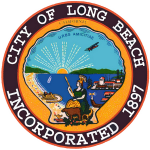Engage + Envision + Empower: Creating a Safe Sex Culture in the City of Long Beach
- Global Health
- Social Entrepreneurship
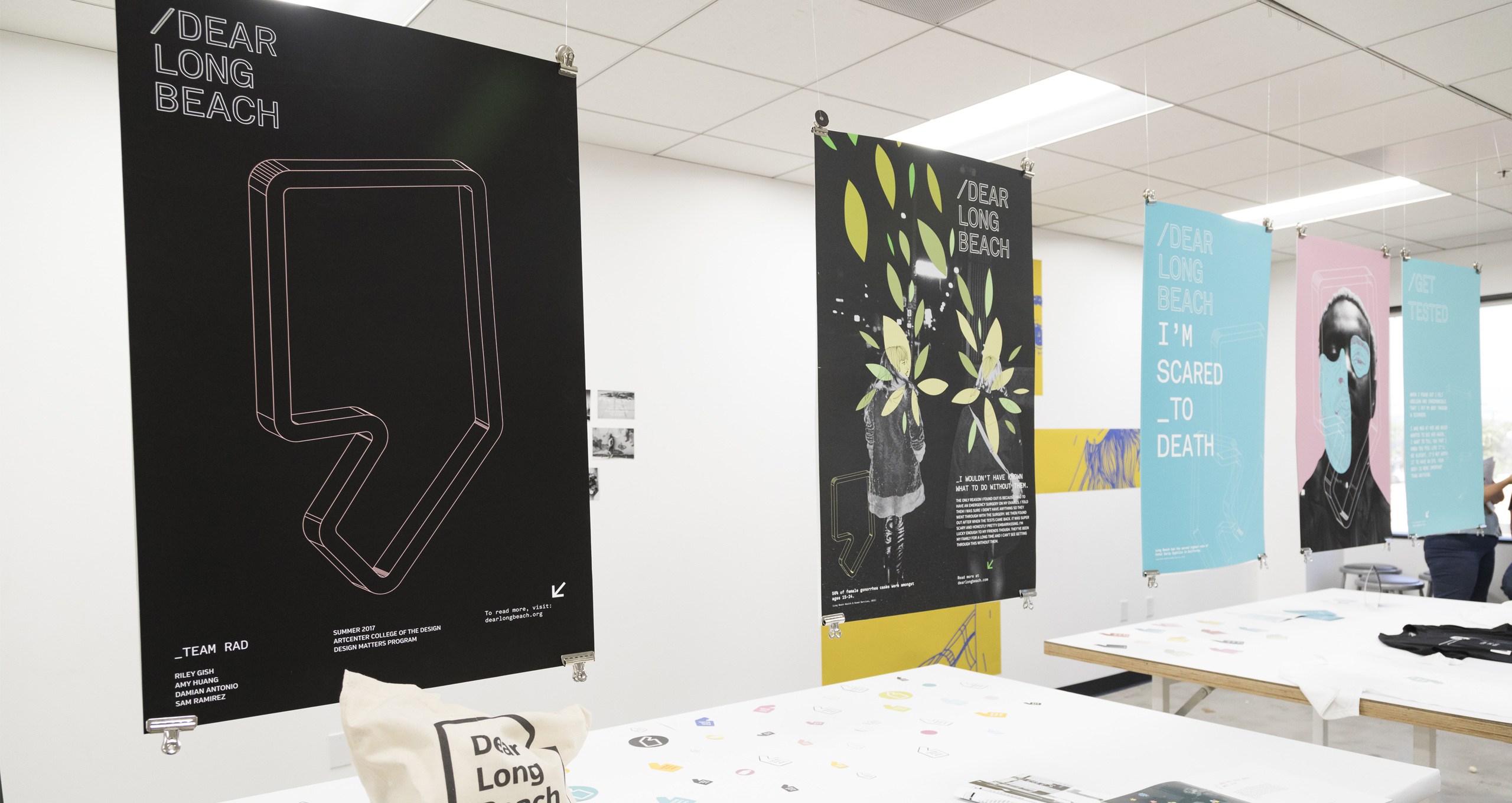
Summer 2017
Engage + Envision + Empower: Creating a Safe Sex Culture in the City of Long Beach Studio, in Summer 2017 challenged ArtCenter students to develop a comprehensive transmedia awareness campaign about safe sex practices for the City of Long Beach which has seen a dramatic increase in the rates of sexually transmitted diseases (STDs) during the past two years.
Using alternative cultural narratives, immersive experiences and interactions with selected professionals, organizations, audiences and the Long Beach community, students designed innovative communication tools that targeted at-risk residents to educate them about safe sex practices and local health resources.
The studio follows a three-day Designstorm Workshop from Spring 2017 that was done in partnership with the City of Long Beach Department of Health and Human Services.
RECENT PROJECT DEVELOPMENTS:
- FALL 2017: The Long Beach Department of Health and Human Services has begun rolling out select pieces of the “Know More” campaign on Instagram, Twitter and Facebook.
- SPRING 2018: Designmatters will move forward with a full-time Fellowship embedded at the Long Beach Department of Health and Human Services. The Fellow will help implement the Know More campaign across the City and devise a plan to roll out the Dear Long Beach campaign.
- SUMMER 2018: Shu Ou, a Product Design student and Spring 2018 Designmatters Fellow facilitated the implementation of the Know More safe sex campaign across the City of Long Beach. Student work originating from our Summer 2017 Studio is now on display in buses, bus shelters and clinics across Long Beach to educate residents about safe sex practices and local health resources.
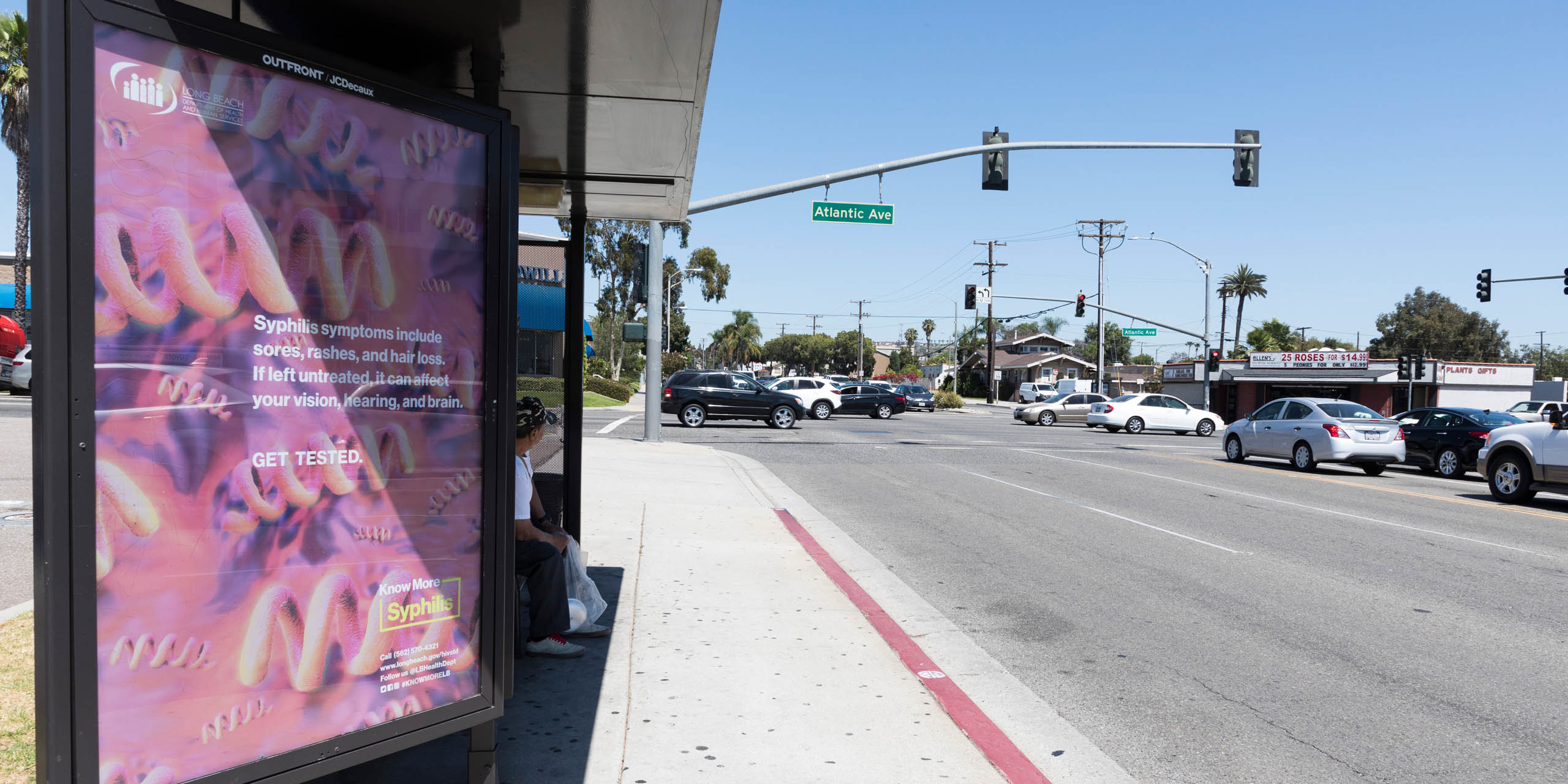
Project Brief
ArtCenter students researched and developed two innovative multiplatform safe sex awareness campaigns targeted for residents of the City of Long Beach, which has seen a dramatic increase of sexually transmitted diseases (STDs) during the past two years.
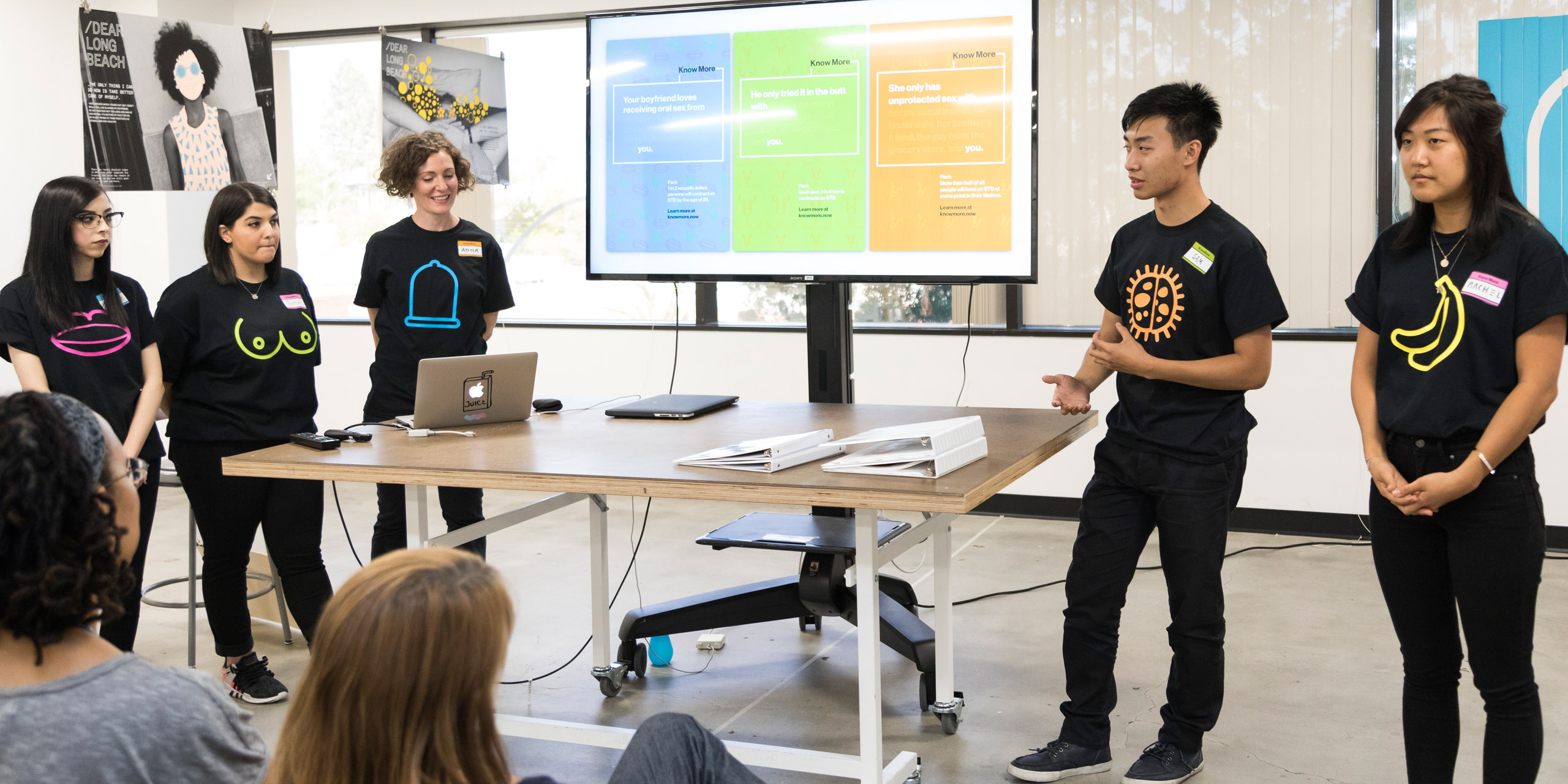
“The ArtCenter students themselves are our target demographic, so they came to this studio with a deeper understanding of how this age group actually feels about the topic. They were able to explore their own fears and doubts and misunderstandings. Through that, they were able to focus to the larger target audience.”
– Marc McMillian, Co-chair of the Long Beach Comprehensive HIV Planning Group and the Executive Director of Getting to Zero
About STDs/HIV-AIDS in the U.S., California and Long Beach
National statistics show an overall increase for STDs including chlamydia, gonorrhea and syphilis.
The rise in STD cases is especially troubling in California where rates are higher than the national average and continue to climb. California’s STD rates are highest among men who have sex with men and young people between the ages of 15 and 24 years old.
In 2016, the national chlamydia rate was 506 per 100,000 individuals, the California state rate was 504 and the Los Angeles County rate was 579. Additionally, health officials report increasing rates between 2015 to 2016 for gonorrhea and syphilis.
The spike in syphilis rates is particularly concerning since an infected pregnant mother can pass syphilis (congenital syphilis) to her newborn baby. Congenital syphilis can lead to bone deformities, blindness, and hearing loss. In 2012, the congenital syphilis rate was 6.6 per 100,000 live births in California; in 2016, the rate jumped to 42 per 100,000 live births. California has the second highest rate of congenital syphilis nationwide, behind Louisiana.
Similarly, the City of Long Beach has seen a record number of STD cases. Long Beach has the second highest rates of chlamydia and syphilis and the third highest rate of gonorrhea in California.
STD rates for Long Beach in 2016 were 802 per 100,000 individuals for chlamydia; 309 per 100,000 individuals for gonorrhea; 64 per 100,000 individuals for syphilis; and 28 per 100,000 individuals who were newly diagnosed with HIV.
Officials in California’s Department of Public Health are unsure why there is such a big jump in both national and state rates, but suggest the rise is probably attributed to many factors including changes in sexual behaviors and evidence that condoms aren’t being used correctly, if at all.
STDs are more common in young adults; officials speculate the reason for the dramatic rise may be because young people who appear otherwise healthy often don’t seek out medical help or STD/HIV screening. Leading busy lives, many young people are abandoning safe sex practices and ignoring the potential dangers of unprotected sex.
Though initial symptoms are mostly mild, STDs can lead to infertility, pelvic inflammatory disease (PID) blindness, hearing loss, and even death. Many STDs are treatable with antibiotics or managed with medication. Overall, the CDC estimated that STDs cost the U.S. health care system approximately $16 billion each year.
Research and Project Development
At the studio kick-off, students visited the project boards, notations and other assets created by their fellow ArtCenter students who, earlier in the year, participated in the spring Designstorm that tackled the same issue of rising STD/HIV rates in Long Beach. Students took notes and snapped photos of the extensive Mind Map, Big Sky ideas, Personas, User Journeys and other materials created during the three-day intensive workshop.
Two students who participated in the Designstorm shared their experiences, discussing key moments and big takeaways which helped set the stage for this current studio.
Students then met with public health officials from the Long Beach Department of Health and Human Services team who presented a sobering overview of HIV/STDs in their community. Statistics of each disease were discussed along with case locations by zip code, demographic percentages and a typical patient profile. Additionally, the Long Beach team outlined the procedures they follow when meeting with patients to conduct a clinical history, perform a physical examination and provide follow-up care.
Students probed for specific details about the data, searching for possible reasons for the spikes in the alarming rates which could inform them in the campaign ideation. The Long Beach team fielded questions about STD misconceptions and discussed Pre-Exposure Prophylaxi (PrEP), a daily anti-HIV medication that keeps HIV negative people from becoming infected.
The Long Beach team provided invaluable resources for the students to learn the history of STDs, the most up-to-date available research and additional background information and context.
For many students, discussing STDs was an eye-opening experience which shattered their own personal stereotypes of who contracts these diseases. The adult nature of the conversation challenged students to look beyond the possible uncomfortable facts of certain sexual behavior to embrace the humanity behind the statistics.
Students were encouraged to push the envelope with regards to what can be created, forgoing typical and well-worn campaign concepts to investigate transmedia options that might not currently be fully exploited. However, students understood that because Long Beach Department of Health and Human Services will adopt their final concepts into a fully-actualized campaign, the budget will ultimately set campaign perimeters.
The topic of human sexuality and health itself also provided a framework for the students; the campaign needed to engage but not lecture; be provocative to a point but not gratuitous. Given the important message of rising STD rates, the campaign should be designed to effectively and efficiently disrupt and interrupt people’s time and attention.
Students were also encouraged to explore partnerships with local entities, media organizations and community personalities who could create synergy to help get the word out. Partnerships could also help financially support the campaign.
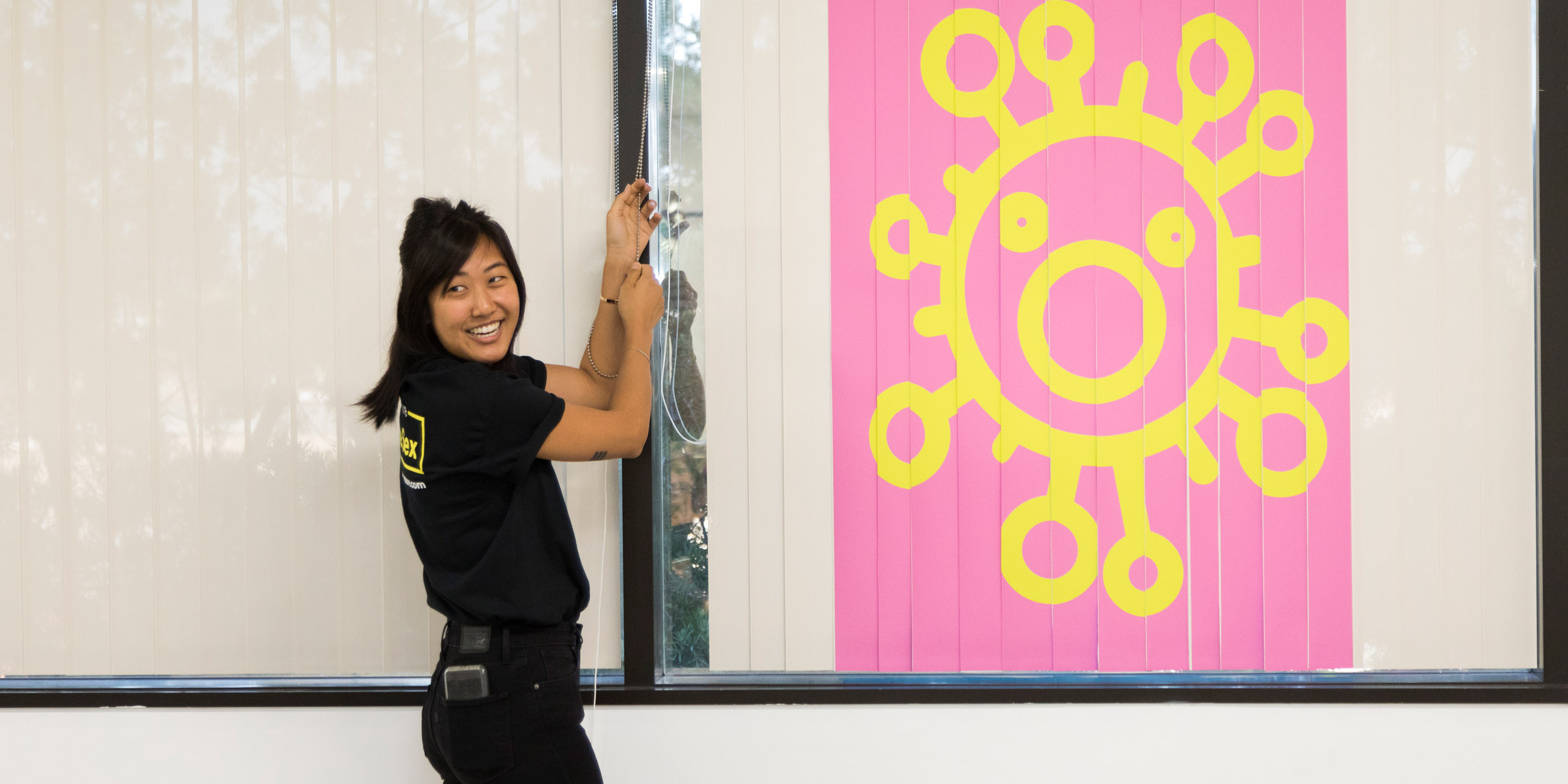
“The idea is to connect with people, get their information but not leave them. Rather, make them a part of the movement – which is what these two campaigns accomplished. They were created to be commandeered by the city and its residents.”
– Tyrone Drake, Faculty, Graphic Design
Divided into teams, students researched, analyzed and sketched out initial concepts. Later, the class would coalesce to present two unifying presentations with each student responsible for a certain aspect of their campaign.
To better understand Long Beach residents, student teams immersed themselves in the community by touring specific neighborhoods, noting which ones reported the highest levels of STDs. They also visited the city’s mobile health clinic van and other community health clinics that receive the bulk of patients requiring STD and HIV counseling and care.
Students also spent time among the people of Long Beach, observing and interacting with them at social locations, including night clubs and bars, and popular community events like the Long Beach Jazz Festival.
Students attempted to blend into the Long Beach culture as if they lived there and faced the issue of rising STDs. Students knew that for their campaigns to be effective as a local movement, they needed to deeply understand and connect with the Long Beach residents.
Students realized field research questions could be difficult and that gathering information required delicate and appropriate language and approach. Questionnaires were developed to collect personal experiences and data in a safe, unobtrusive manner.
Armed with knowledge, background and resources, students started to see Long Beach in a new light. Students gained the trust of residents who offered key insights and honestly shared experiences and thoughts on extremely personal matters of sexuality. Students also discovered a high level of misconceptions about STDs as well as stigma and shame associated with certain sexual practices.
Ideation required students to examine how their thinking could address a specific aspect of the problem of high STD rates in Long Beach. Students relied on resources and research to steer them to a natural conclusion of how best to structure their awareness campaigns.
At the midterm, students presented five concepts to the Long Beach Health and Human Services team who provided generous and insightful feedback. Student teams than narrowed down the campaigns to two workable concepts: one emotionally targeted and the other based on facts and geared toward sexual education.
Teams then worked to refine and hone their campaigns by prototyping working samples and models as well as devising implementation strategies on how campaigns could be physically actualized in Long Beach.
Students designed logos, selected typefaces and created color pallete guidelines that would be compiled into a graphics manual. Posters and other visual ancillary branding products were created to show the range and depth of their campaigns; social media and website mockups were designed.
Students also created a list of collaborative partners that could help get the word out about the campaign and its contents.
As they fleshed out the final elements to their campaigns, students kept considering how to involve innovative strategies that are also cost-effective and immediately workable for the Long Beach team and their budget.
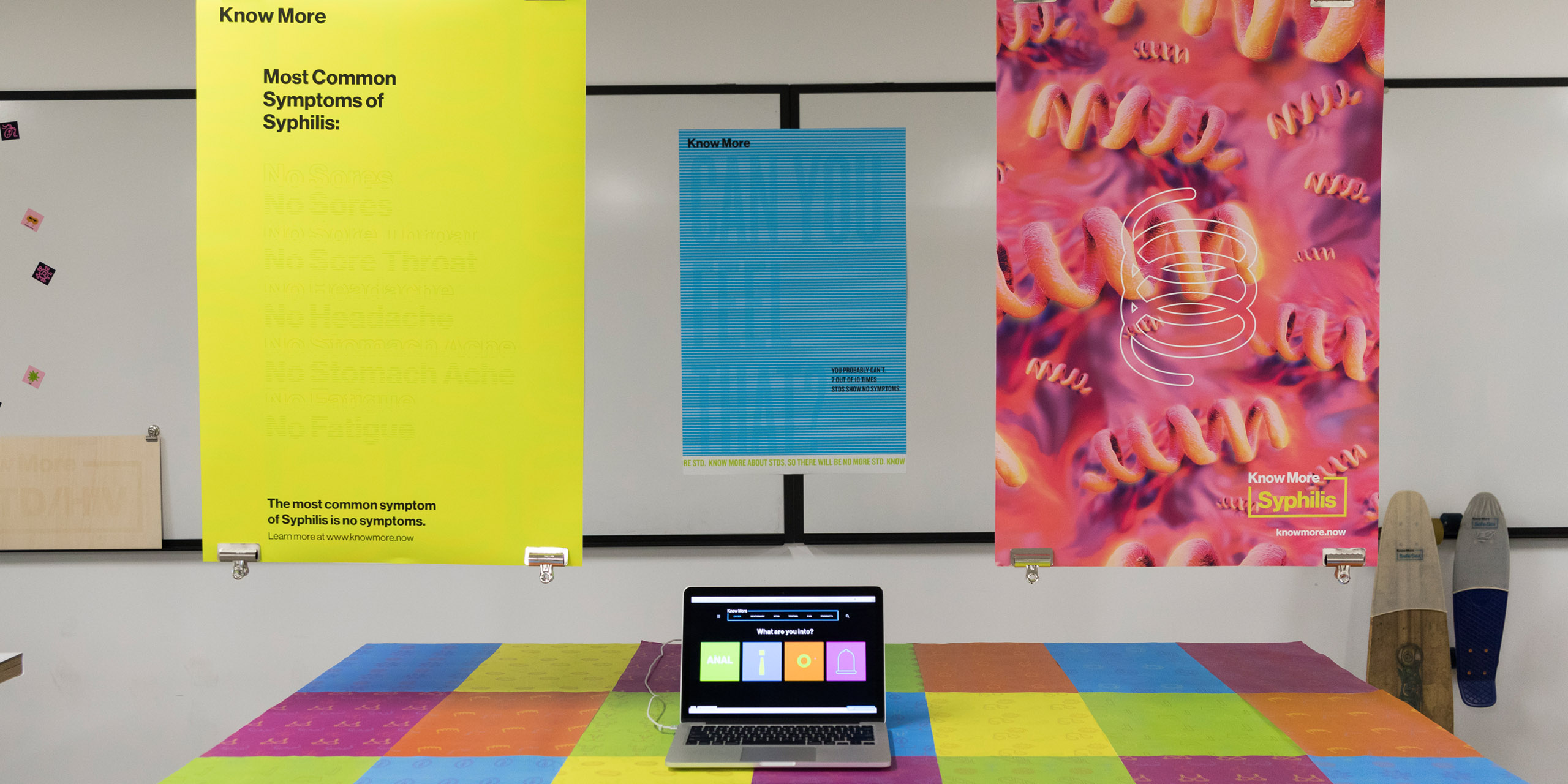
“These campaigns draw us in, they are attractive and interactive. I’m a clinician, I teach this and see patients. These campaigns will help me get the message across quicker and more direct. This will increase my toolbox of being able to educate and inform the community, providers and patients. A lot of providers don’t get to hear stories from their patients. A lot of providers don’t see HIV and STD patients everyday – and these campaigns may encourage providers to be a little more compassionate about who they are seeing.”
– Deborah Collins, MD, STD Controller and HIV Director, City of Long Beach Department of Health & Human Services
Project Outcomes
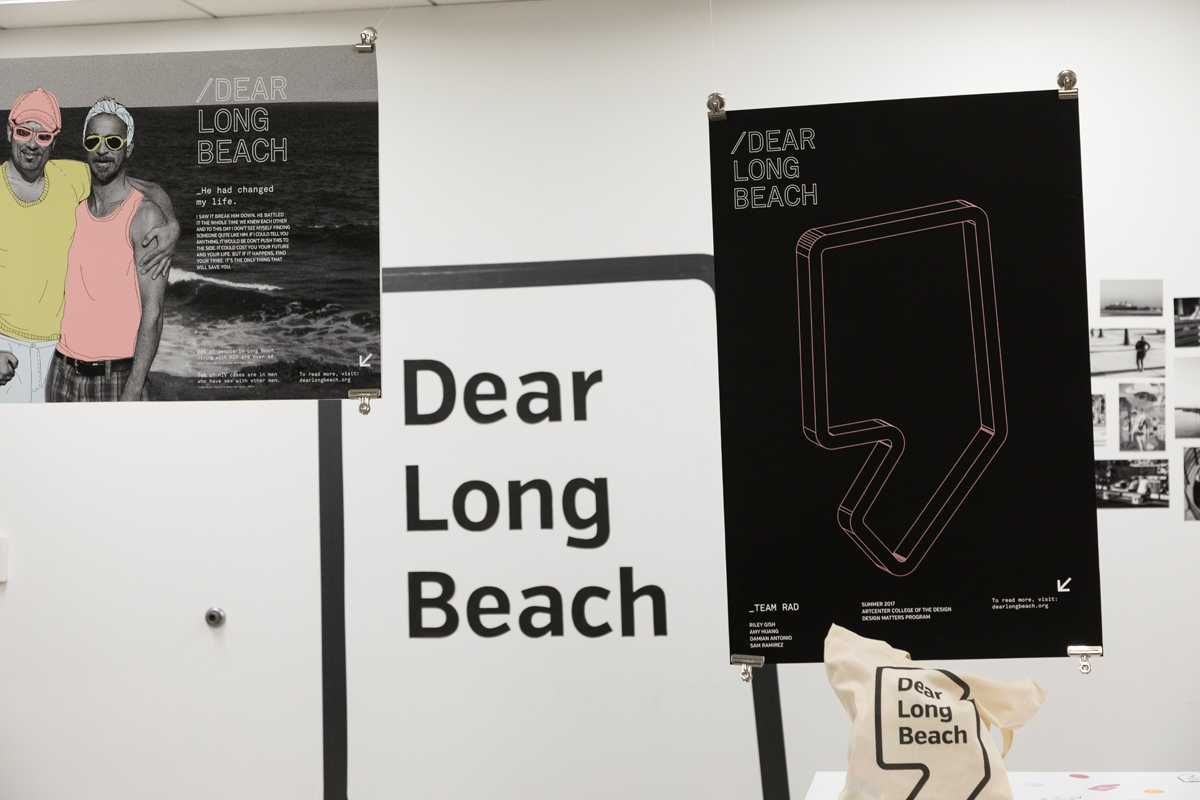 close
close
Dear Long Beach Campaign
Read more
This campaign targets emotions along with the civic pride and love that residents of Long Beach have for their community.
Through powerful visuals, personal stories and with an authentic voice, this empathetic campaign engages the viewer to compassionately respond to the health crisis as well as examine their own sexual behavior and encouraging viewers to consider taking incremental steps toward healthier sexual activities.
The campaign features four components: print, social media, spatial experiences and brand extension products. All engagements lead the viewer to the Dear Long Beach website where visitors can learn more information, create their own portrait and story, write their own letter to Long Beach, and schedule an appointment for testing/counseling.
The print component utilizes a distinct mixed media art style and a centralized logo. Candid black and white photographic portraits are overlaid with illustrative colors that are carefully positioned to hide the identities of the photographed storyteller(s). These grainy black and white photos are artistically highlighted with muted color palette illustrations. Headlines are eye-catching, bold statements that draw the viewer in to read these short but poignant first-person accounts of sexual behavior and the resulting complications (pregnancy, receiving STDs, etc.). The Dear Long Beach team created an anonymous online survey that was completed by real people, whose stories appeared in the posters and have a candid and conversational tone.
Complementing the photo/illustrated visuals is the Dear Long Beach logo: an opening quotation mark that evokes a beginning statement or the start of a conversation. Print imagery also features a computer command symbol – a forward slash – preceding the headlines.
At the bottom of all print work is a quick fact about STDs, condom use, etc. that relates to the story told and acts as a call to action to contact the website for more information.
Photo/illustration imagery and quotation mark logo are employed for posters, postcards, standees, condom packaging and can be incorporated into the current Know Your Risk pamphlet that is distributed by Long Beach health care officials.
Social media outlets can offer information, interaction and support for residents. The Dear Long Beach Facebook Page can demonstrate a support system; followers can overlay the quotation mark logo over their profile picture as a sign of solidarity. Instagram posts reflect the print visuals emotions which can spark curiosity and conversations. Followers can use the hashtag #dearlongbeach and art-styled stickers to cover their identity similar to the print visuals. Snapchat users can also use a version of the quotation mark logo in their posts. Additionally, an online podcast offers listeners a human voice sharing the sexual behavior story, further humanizing the topic without being judgmental or condescending.
3-D spatials further connect the campaign stories of Long Beach to its residents. Mobile clinic vans are rebranded on the outside with the colorful quotation mark logo imagery. Inside the redesigned clinic, logos and photos/illustration graphics present a friendly, open environment.
Civic and local art partners can assist with incorporating the campaign graphics into galleries, art installations and unexpected public spaces such as staircases, bathroom mirrors and walls that extend off the surface onto walkways. A mural wall of the colorful graphics can be the backdrop of selfie and social media photos, a subtle extension of the campaign. A well-trafficked city wall can also be where residents can post their own love letters to Long Beach.
The quotation mark logo can be transformed into 3-D sculptures and standees to provide interest in public places.
Expanding the brand identity to specific products include Dear Long Beach imagery on t-shirts, tote bags, underwear, bandanas and flags, especially incorporating the logo into the rainbow pride flag. When large quotation mark logo stickers are peeled, a short personal story is revealed underneath. All campaign visuals can be packaged in a zine-like collectible volume which can be sold, distributed and/or be available at mobile clinics.
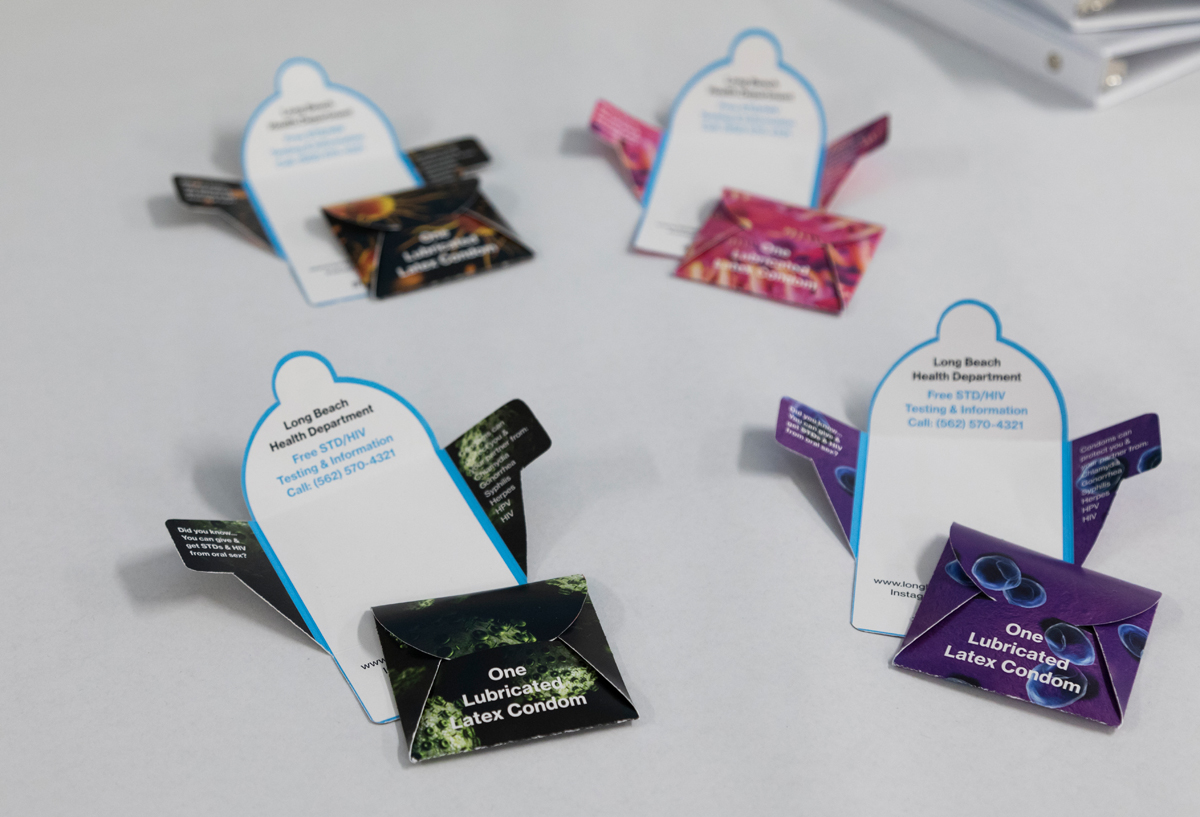 close
close
Know More Campaign
Read more
By presenting straightforward information about sexual practices and the reality of STDs, this campaign seeks to debunk misconceptions and encourage safe sex practices, condom use and testing rates among Long Beach’s younger generations.
Through engaging and light-hearted graphic designs, this sexual education campaign promotes positive sexual messaging that focuses on the facts in an empowering and honest presentation: “Know More About STDs So There Will Be No More STDs.”
The graphic-heavy campaign consists of a typographical and iconographic series of imagery as well as a cellular pattern series.
The typographical series involves an effective graphic device that illustrates the realities of having STDs. Colorful posters appear to be blank, but subtle, faint text explain how gonorrhea, syphilis and chlamydia are often symptom-less. A call to action at the bottom of the posters encourages readers to check out the Know More website.
Posters can be placed in Long Beach public bathrooms, clothing store dressing rooms and in high school hallways as well as on social porn sites to engage the target group.
Smaller versions of the posters can be printed onto playing cards in a similar fashion to Cards Against Humanity. Cards can be distributed at bars and other social gatherings for patrons to play a game about STDs which can further desensitize the topic and start conversations in a less embarrassing manner.
The iconographic series features an icon emoji-like language that presents sexual parts and practices in a playful and fun way without complicated terms or labeling specific sexual lifestyles.
Colorful pictographs are employed on a variety of print and products that grab attention and communicate facts about sexuality and relationships in a quick and effective, non-judgmental way.
Using the graphic device of underlying faint text, a series of posters shed light on misconceptions and sexual relationships that often end in heartbreak. An open-framed Know More logo provides space to describe situations and present facts; colorful shadow icons provide backdrops.
The icons themselves can be branded on t-shirts, phone cases, keychains and a variety of condom sleeve cases each geared for different sexual practices. Life-size dice with icon images can be rolled to match up body parts and be a conversation catalyst about sexual behavior at local colleges and universities.
The Know More logo can be applied around Long Beach at familiar and surprising locations – mail boxes, manhole covers, etc. – to further connect the campaign on a public street level to residents.
The cellular pattern series involves colorful eye-catching representations of actual STD cells which brings another layer of graphics into the campaign’s educational toolkit.
Informational health pamphlets about the various STDs are redesigned and branded utilizing the cellular patterns and icons to create a fresher and more inviting product.
Large posters, condom sleeves and other products such as underwear, t-shirts and Vans tennis shoes – and even the Long Beach Health Department mobile clinics – can also use similar branding graphics of cellular patterns and pictographs.
An animated rap-style video about STDs that is both humorous and educational can be shared on social media and be played at the clinic waiting room.
Finally, visitors to the rebranded Know More website will be welcomed by colorful icons depicting sexual anatomy and behavior. Along with a sex-ionary that describes sexual practices and outlines the risks involved in each behavior, the website contains links to testing schedules and appointments. Additionally, viewers can find a page to purchase products as well as downloads gifs and videos for social sharing.
Project Publicity
Video Documentation
“This studio was challenging because of the complexity of the topic; there’s no absolute right way to talk about this topic. These solutions are indeed subjective – this isn’t solving a clear-cut math problem – and that proved to be the most difficult aspect of the project. The solutions, however, do address all the key elements, massaged by the student’s vision.”
– Dennis Lee, Faculty, Advertising
“When you are in government, you don’t normally have access to this type of creativity; you sit in a different world. The energy and the creativity of this studio has been so much fun. I have a lot of empty walls and I can’t wait to put these posters up right now.”
– Kelly Colopy, Director, City of Long Beach Department of Health & Human Services
“At the kick off, there was a lot of information to take in. Those first few weeks of research was more than I have ever done! Advertising is all about concepts. I’m used to taking a subject and coming up with interesting angles. I’m not used to working with other people outside my major. There was a lot of work with other perspectives which really helped us all in the end. I’m happy we came up with something emotional. A lot of what I have been involved with in the past has been light-hearted and it felt good to do something different and broaden my breadth of work.”
– Damian Antonio, Student, Advertising




